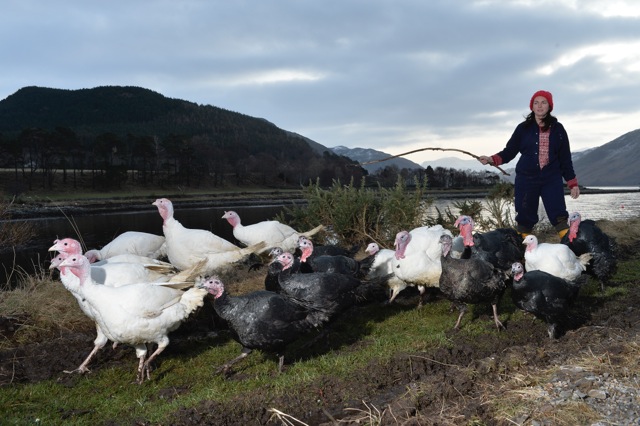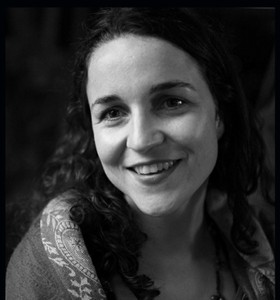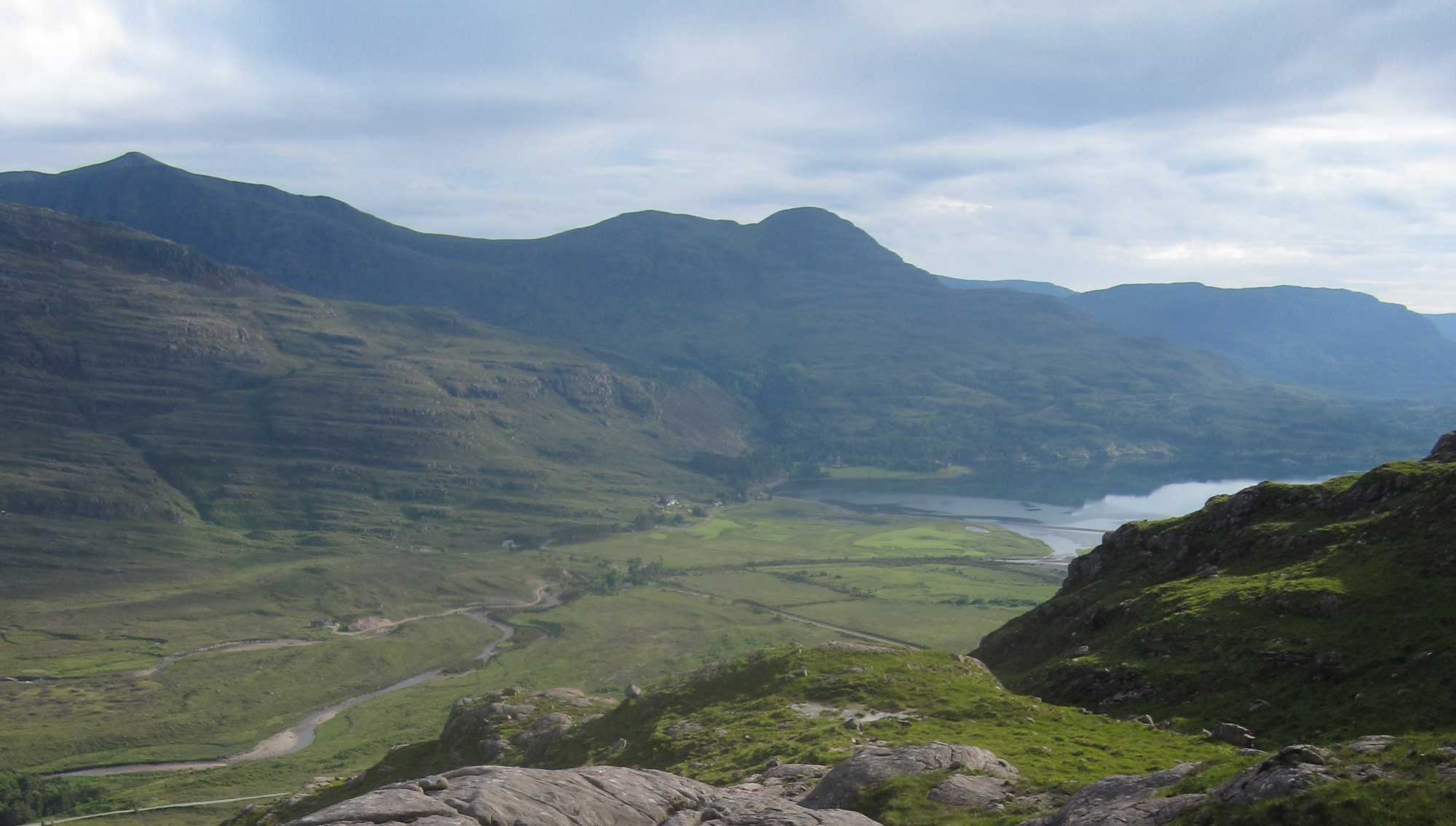Winter never quite settles in the West Highlands. Snow dusts the top of the mountains and ice creeps around the edge of the black lochs.
We drive over the Braemore Hills, keeping an eye out for the deer hidden in the burnt landscape, only visible by their soft white rumps and antlers against the skyline.
The woods coming down into Ullapool feel like a blanket and the farmhouses look warm and cosy, with the windows still lit up in the midwinter morning. Leckmelm Farm is just waking up, tarpaulin flaps in the breeze and the sheep are stirring in the byre. I spot the turkeys first, already pecking about by the shoreline of Loch Broom. I get out the car and cough. They gobble back, the surprisingly musical cascade like rusty chimes catching in the breeze.
The farmer Lucy Beattie arrives in her Volvo, fresh from dropping off three children at school, and hurtling towards the next job. She ushers us into a holiday cottage for a health and safety briefing. ‘Team Turkey’ are a motley crew: A stockman, a gamekeeper, a schoolboy, a childminder – and me, the writer. We sip tea and squeeze our layers of woollen jumpers into boiler suits.
I have come to watch Lucy kill turkeys as part of my ongoing project to discover where our meat comes from. Where I cannot kill meat myself, I intend to watch the process in order to consider the ethics of eating animals. It’s Christmas and I don’t want to ruin anyone’s dinner, but I do want to explain how turkey reaches the table.
Lucy, 38, has done this for ten years but she’s a little apprehensive this year as these turkeys are special. In August her farm was submerged in three feet of water rushing down from the mountains in the aftermath of Hurricane Bertha. The turkey chicks were luckily on high ground but had to be moved up to a shed by the farmhouse for a few days. They have shown remarkable pluck in their short lives, crossing the burn to neighbouring farms and even the road, causing a rare traffic jam.
But Lucy has a family to feed and moreover 50 people in the local community waiting for a free-range Christmas turkey, including the manager of Tesco. The smaller birds are sold for £22 in Ullapool. It would cost hundreds in London.
The turkeys to be killed today have been kept in a shed for the previous 12 hours with no food, so the gut is empty and there is less chance of contaminating the meat. Duncan, the stockman, moves in calmly and quietly and picks up a hen in a bear hug. She looks surprised but not distressed.
The slaughter happens in the yard on a home made contraption fashioned out of wood and traffic cones. A stainless steel ready-made machine is available but Lucy couldn’t afford it, so she cut the bottom off the cones and used them as round plastic holes in a high wooden bench. The turkey is lowered into the hole so the wings are tucked in and only its head is hanging out. Lucy moves in with her electric stunner and “fries the turkey’s brain”. The instrument is clamped on its head and she counts for “10 elephants”. Lucy checks the animal is dead by touching the eyes and checking it can no longer blink. I watch the huge turkey feet stretch out and splay, like dinosaur prints. Then it is over. The throat is cut and the blood makes a tinkling sound as it drains into the plastic bucket.
“I’m the softest person, I know,” she says quietly. “I just have to get on with it.”
Lucy did a three day course with the Humane Slaughter Association to learn to kill turkeys. But that’s not why I am able to watch this annual process without being too upset. It is because I trust her. I know she is a good person who passionately believes in raising and killing animals in an humane way.
A few weeks ago I visited a slaughter house for the first time to see pigs killed. All the rules and regulations were followed and I saw nothing illegal. But I found it extremely distressing and am still struggling to find a way to write about it. In contrast, watching Lucy kill the turkeys was not nice, but I did not feel panicked by an industrial process that was full of fear and over which I had no control.
I wonder whether we should only eat meat killed by people we trust. It sounds obvious but its surprising how far we have come away from this simple concept. Someone like Bernard Matthews used the idea of trust to sell his ‘boot-i-ful’ turkeys, assuming that the customer would buy the birds from a man they feel they know. He was probably right, but did they really know how the birds were slaughtered and processed?
Once they are killed Lucy’s turkeys are hung in the larder, built with the help of a grant from the government for butchering venison and other animals. We wash our hands and take a turkey each starting on the breast of the bird. This is the first thing customers look at and has to be perfect. In bigger farms the turkeys will be put through plucking machines, but this takes away some of the fat and means the birds do not taste as good. Team Turkey not only pluck the birds but finish it off with tweezers a few days later to make sure it is absolutely clean.
The larder soon looks like the aftermath of a serious pillow fight, as feathers float down through the hot mist of our breaths. I want to say it was somehow festive, the feathers falling like snow, but honestly? It’s a smelly job. Turkeys are not beautiful birds, the bulbous blue noses hang over the beaks soaked in blood, the outer feathers are stiff and yellow, only the soft underfeathers downy white. We move on to black turkeys and I watch my fingers turning blue from the ‘ink’ inside the quills. Who knew turkeys had ink in their feathers or strange little beards like wire wool on their plucked necks? We are told to pluck the bird until the neck is “like an Elizabethan ruff”. The feathers fill my nose and gather at my feet like a duvet. Even so, in the refrigerated larder my feet are freezing cold, though my hands are warm from the turkey. The plucked flesh feels like the inside of a dog’s ear. We chat and joke and a camaraderie falls on the room. Lucy shows Clifford from the council’s food safety department around in his little white catering hat. She has a spot of blood on her glasses.
We stop for mince pies and chocolate at lunchtime. Everyone picks at their food, shares local gossip and plans for Christmas, what they are going to do with this little bit of extra money. The remaining turkeys stand outside the window like a group of old ladies at a hunt ball, staring in accusingly over their fan-tails. Later they will be rounded up to be processed tomorrow in front of local school children, so the next generation can also learn where Christmas dinner comes from.
Even though I am not doing as much as the rest, I find the afternoon more difficult. I have to use my full weight to pull out the wing feathers, leaving the tail to be wrenched out with plyers. By the time the light is dying outside we have a dozen turkeys hanging in the larder to be “finished and tweezered” in a couple of days. They look like they do in the butchers, just an object, a Christmas gift.
I bum a cigarette and go outside to phone my sister. At least the taste of stale tobacco is better than the smell of dead turkeys.
“I keep on having these dreams,” I tell her. “Since the pigs, and the pheasants…”
“What kind of dreams?”
“Feathers growing out of the back of my arms.”
“Oh, an Icarus dream…”
I look out at the black loch, will I fall? Sometimes this project seems too much. I started out with a simple enough concept, to investigate how the animals we eat die. It seemed like a good idea, my responsibility even, and I was encouraged by the reaction from people who eat meat and want to know where it comes from. But it is hard not to feel sad every time I see an animal die, even if it is done like this, in the most humane way possible. What am I, but just an animal?
I go back inside to wash away the smell. There is still turkey ink on my fingers. I scrub and scrub to try and get it off, until I realise it is just the ink from my pen.



